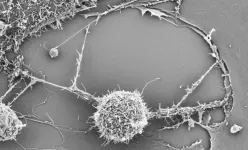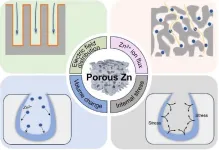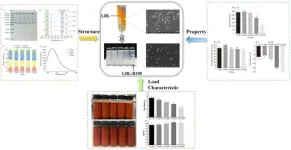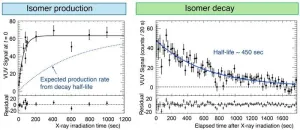(Press-News.org) Fighting cancer is exhausting for T cells. Hostile tumor microenvironments can drain their mitochondrial activity, leading to a condition known as T cell exhaustion. This phenomenon also hinders adoptive cell therapies, in which healthy, tumor-targeting T cells are infused into patients with cancer. A novel method to boost mitochondrial activity and charge up T cells is needed.
Investigators from Brigham and Women’s Hospital, a founding member of the Mass General Brigham healthcare system, in collaboration with colleagues at Leibniz Institute for Immunotherapy in Germany, have developed a way to “supercharge” T cells by supplying them with extra mitochondria from multipotent stromal cells. In a new study published in Cell, researchers report that these supercharged T cells exhibited heightened anti-tumor activity and reduced signs of exhaustion in preclinical models of cancer, suggesting that this technique could help improve existing immunotherapies.
“These supercharged T cells overcome one of the fundamental barriers of immunotherapy by penetrating the tumor and overcoming immune barren state in the tumor,” said corresponding author Shiladitya Sengupta, PhD, of the Brigham’s Department of Medicine. “Mitochondria provide the fuel. It’s like we’re taking T cells to the fuel station and gassing them up. This transplanting of mitochondria is the dawn of organellar therapy where an organelle is delivered to a cell to make it more effective.”
“Previous efforts to enhance mitochondrial function in T cells have focused on targeting specific genes or pathways, but these methods fall short when the mitochondria are already damaged or dysfunctional. Our approach involves the transfer of whole, healthy mitochondria organelles into the cells. This process is comparable to organ transplantation—like heart, liver, or kidney transplants—but conducted at a microscopic level,” explained Luca Gattinoni, MD, co-leading author of the study.
To develop this method, the researchers built upon their previous findings, which showed that cancer cells can slurp up mitochondria from immune cells through intercellular nanotubes that the researchers have described as “tiny tentacles.” Drawing from these results, the group teamed up with scientists at the Leibniz Institute to investigate interactions between bone marrow stromal cells (BMSCs) and cytotoxic T cells. Using varied electron and fluorescent microscopy approaches, they observed that BMSCs extended nanotubes to activated T cells, donating intact mitochondria. This helped to revive the T cells (mito+), which showed increased respiratory capacity, a sign of enhanced metabolism.
The research team examined how supercharging the T cells affected immune function. When infused into a mouse model of melanoma, mito+ cells showed significantly higher anti-tumor responses and prolonged survival rates compared to T cells without additional mitochondria. Further experiments revealed that mito+ cells could easily penetrate tumors, multiply quickly and pass on their extra mitochondria to daughter cells, where they persisted for a long time. In addition, the authors discovered that mito+ cells could survive and resist T cell exhaustion within the tumor microenvironment.
The researchers found that supercharging human T cells helped the immune system fight tumors in multiple models of cancer. Of note, they demonstrated that tumor-infiltrating lymphocytes and CAR-Ts, which often develop damaged mitochondria within the tumor microenvironment, displayed augmented cancer-destroying properties when boosted with mitochondria from primary BMSCs from human donors.
The authors suggest that future applications could include using patient-matched BMSCs to supercharge T cells for adoptive transfer.
Authorship: In addition to Gupta, BWH authors include Tanmoy Saha. Additional authors include Jeremy G. Baldwin, Christoph Heuser-Loy, Roland Schelker, Dragana Slavkovic-Lukic, Nicholas Strieder, Inmaculada Hernandez-Lopez, Nisha Rana, Markus Barden, Fabio Mastrogiovanni, Azucena Martín-Santos, Andrea Raimondi, Philip Brohawn, Brandon W. Higgs, Claudia Gebhard, Veena Kapoor, William G. Telford, Sanjivan Gautam, Maria Xydia, Philipp Beckhove, Sina Frischholz, Kilian Schober, Zacharias Kontarakis, Matteo Iannacone, Jessica Fioravanti.
Disclosures: Baldwin, Saha, Fioravanti, Sengupta, and Gattinoni have a patent application for the use of mitochondrial transfer technology in cancer immunotherapies. Brohawn and Gautam have an employee relationship and have stock in AstraZeneca. Higgs has an employee relationship and has stock in Genmab. Gattinoni has consulting agreements with Lyell Immunopharma, Instil Bio, and Advaxis. Gattinoni is on the scientific advisory board of Poseida Therapeutics and Kiromic and a stockholder of Poseida Therapeutics. Iannocone participates in advisory boards/consultancies for Gilead Sciences, Third Rock Ventures, Antios Therapeutics, Asher Biotherapeutics, GentiBio, Clexio Biosciences, Sybilla, and BlueJay Therapeutics. Fioravanti has an employee relationship and has stock in Lyell Immunopharma. Sengupta is a founder and owns equity in Vyome Therapeutics Inc. and Alyssum Therapeutics Inc.
Funding: This research was supported by the NIH Intramural Research Program through an NCI FLEX award, the CRI Clinic and Laboratory Integration Program (CLIP) (CRI3201), NIH-NCI RO1s RO1CA293908 and RO1CA276525 and the DFG Reinhart Koselleck project (GA 2882/2-1).
Paper cited: Baldwin JG et al. “Intercellular nanotube-mediated mitochondrial transfer enhances T cell metabolic fitness and antitumor efficacy” Cell DOI: 10.1016/j.cell.2024.08.029
END
Study finds ‘supercharging’ T cells with mitochondria enhances their antitumor activity
Brigham researchers develop strategy to improve immunotherapy by helping T cells penetrate and kill tumor cells
2024-09-13
ELSE PRESS RELEASES FROM THIS DATE:
Harnessing the power of porosity: A new era for aqueous zinc-ion batteries and large-scale energy storage
2024-09-13
As the global demand for energy storage solutions grows, the limitations of current lithium-ion batteries, such as safety concerns and high costs, have driven the exploration of alternative technologies. Aqueous zinc-ion batteries (AZIBs) have emerged as a promising candidate due to their inherent safety, cost-effectiveness, and environmental sustainability. However, challenges like zinc dendrite growth continue to hinder their widespread adoption. Due to these challenges, there is a pressing need to delve deeper ...
Antibody-drug conjugate found effective against brain metastases in patients with HER2-positive breast cancer
2024-09-13
Trastuzumab deruxtecan shows substantial anti-cancer activity in brain metastases in patients with HER2-positive breast cancer in major international clinical trial
Results confirm findings of previous, smaller studies
BARCELONA, Spain - A drug that delivers chemotherapy directly to tumors has shown impressive activity against some of the hardest-to-reach cancer cells: those that have spread to the brain in patients with advanced HER2-positive breast cancer. The findings, from an international clinical trial led by Dana-Farber Cancer Institute researchers, reinforce earlier findings of the benefits ...
Bacteria work together to thrive in difficult conditions
2024-09-13
COLUMBUS, Ohio – Though a founding concept of ecology suggests that the physical environment determines where organisms can survive, modern scientists have suspected there is more to the story of how microbial communities form in the soil.
In a new study, researchers have determined through both statistical analysis and in experiments that soil pH is a driver of microbial community composition – but that the need to address toxicity released during nitrogen cycling ultimately shapes the final microbial community.
“The physical environment is affecting the nature of microbial interactions, and that affects the assembly of the community,” ...
An ‘invasive’ marine organism has become an economic resource in the eastern Mediterranean
2024-09-13
Media Contact:
John Dudley
(814) 490-3290 (cell)
jjdudley@usf.edu
KEY TAKEAWAYS:
A species of single-celled organisms called foraminifera (forams) is increasing in warm, alkaline waters of the eastern Mediterranean, building beaches with their calcium carbonate skeletons.
In regions like Turke, forams are creating sandy shorelines where there used to be rocky terrain, benefiting tourism.
Forams thrive in warm waters with high CO2, suggesting they might continue growing as climate change accelerates.
This species of foram, once native to the Mediterranean, is returning as human activities make ...
Unveiling the math behind your calendar
2024-09-13
In a world where organizing a simple meeting can feel like herding cats, new research from Case Western Reserve University reveals just how challenging finding a suitable meeting time becomes as the number of participants grows.
The study, published in the European Physical Journal B, dives into the mathematical complexities of this common task, offering new insights into why scheduling often feels so impossible.
“If you like to think the worst about people, then this study might be for you,” quipped researcher Harsh Mathur, ...
New research finds employees feel pressure to work while sick, which has been shown to cost companies billions
2024-09-13
EMBARGOED FOR RELEASE UNTIL 9 A.M. ET ON SEPT. 13, 2024
TAMPA, Fla. (Sept. 10, 2024) – Employees often feel pressure to work while sick, leading to lost productivity, deviant behaviors such as theft and mistreatment of coworkers and intent to leave the organization, according to new research led by University of South Florida Assistant Professor of Psychology Claire Smith. The cost of such behavior, known as “presenteeism,” can be staggering – as much as $150 billion annually, according to Harvard Business Review.
The findings will be ...
Harnessing egg yolk power: A new approach to paprika oleoresin stability
2024-09-13
Paprika oleoresin (PO), extracted from chili peppers, is renowned for its vibrant color and beneficial health properties, such as antioxidant and anti-inflammatory effects. However, its lipophilic nature and sensitivity to factors like oxygen, heat, and light restrict its use in water-based foods. While previous approaches, including emulsions and liposomes, have aimed to improve PO’s stability, the results have been limited. These persistent challenges underscore the need for new stabilization methods for PO.
The study (DOI: 10.26599/FSAP.2024.9240064), led by scientists from Chengdu University and Huazhong Agricultural ...
Millions of depressed Americans could benefit from psychedelic therapy, study finds
2024-09-13
Atlanta, Georgia - In the wake of mounting evidence for the efficacy of psychedelic-assisted therapies, the U.S. Food and Drug Administration (FDA) is considering approving psilocybin, the active ingredient in “magic mushrooms,” for treating depression in the near future. As this watershed moment approaches, a critical question arises: Just how many people might stand to benefit from this promising but still unproven therapy?
Shedding light on this high-stakes inquiry, a first-of-its-kind peer-reviewed study led by researchers at Emory University, the University of Wisconsin-Madison and ...
Towards the realization of compact and portable nuclear clocks
2024-09-13
Scientists use atomic clocks to measure ‘second,’ the smallest standard unit of time, with great precision. These clocks use natural oscillations of electrons in atoms, similar to how pendulums work in old grandfather clocks. The quest for an even more precise timekeeper led to the discovery of nuclear clocks, which use the transitions of atomic nuclei instead of electrons to keep time.
A rising contender for the development of ultra-precise nuclear optical clocks is the nuclear first-excited state of 229Th isotope. Its long half-life of 103 seconds and low excitation energy of a few electron ...
Global warming's economic blow: Risks rise more rapidly for the rich
2024-09-13
In a new study by the Potsdam Institute for Climate Impact Research (PIK), researchers analysed how erratic weather events, increasingly intensified by global warming, affect global production and consumption across different income groups. The results confirm previous studies that the poorest people worldwide bear the greatest economic risks from climate change. Surprisingly, the risk for the wealthy is growing the fastest. Economies in transition like Brazil or China are also highly vulnerable to severe impacts and negative trade ...
LAST 30 PRESS RELEASES:
Tracing the quick synthesis of an industrially important catalyst
New software sheds light on cancer’s hidden genetic networks
UT Health San Antonio awarded $3 million in CPRIT grants to bolster cancer research and prevention efforts in South Texas
Third symposium spotlights global challenge of new contaminants in China’s fight against pollution
From straw to soil harmony: International team reveals how biochar supercharges carbon-smart farming
Myeloma: How AI is redrawing the map of cancer care
Manhattan E. Charurat, Ph.D., MHS invested as the Homer and Martha Gudelsky Distinguished Professor in Medicine at the University of Maryland School of Medicine
Insilico Medicine’s Pharma.AI Q4 Winter Launch Recap: Revolutionizing drug discovery with cutting-edge AI innovations, accelerating the path to pharmaceutical superintelligence
Nanoplastics have diet-dependent impacts on digestive system health
Brain neuron death occurs throughout life and increases with age, a natural human protein drug may halt neuron death in Alzheimer’s disease
SPIE and CLP announce the recipients of the 2025 Advanced Photonics Young Innovator Award
Lessons from the Caldor Fire’s Christmas Valley ‘Miracle’
Ant societies rose by trading individual protection for collective power
Research reveals how ancient viral DNA shapes early embryonic development
A molecular gatekeeper that controls protein synthesis
New ‘cloaking device’ concept to shield sensitive tech from magnetic fields
Researchers show impact of mountain building and climate change on alpine biodiversity
Study models the transition from Neanderthals to modern humans in Europe
University of Phoenix College of Doctoral Studies releases white paper on AI-driven skilling to reduce burnout and restore worker autonomy
AIs fail at the game of visual “telephone”
The levers for a sustainable food system
Potential changes in US homelessness by ending federal support for housing first programs
Vulnerability of large language models to prompt injection when providing medical advice
Researchers develop new system for high-energy-density, long-life, multi-electron transfer bromine-based flow batteries
Ending federal support for housing first programs could increase U.S. homelessness by 5% in one year, new JAMA study finds
New research uncovers molecular ‘safety switch’ shielding cancers from immune attack
Bacteria resisting viral infection can still sink carbon to ocean floor
Younger biological age may increase depression risk in older women during COVID-19
Bharat Innovates 2026 National Basecamp Showcases India’s Most Promising Deep-Tech Ventures
Here’s what determines whether your income level rises or falls
[Press-News.org] Study finds ‘supercharging’ T cells with mitochondria enhances their antitumor activityBrigham researchers develop strategy to improve immunotherapy by helping T cells penetrate and kill tumor cells






